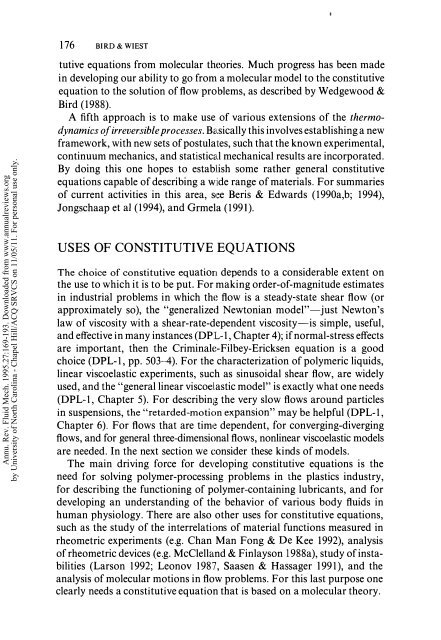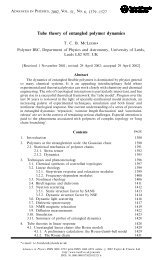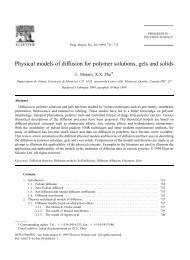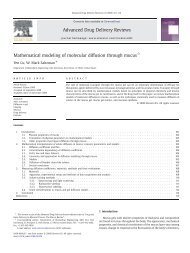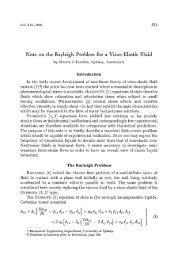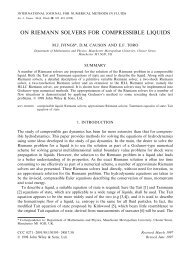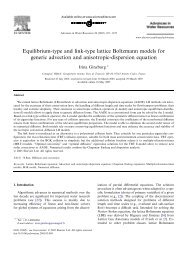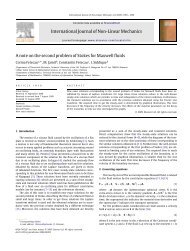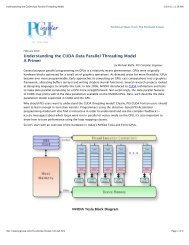Constitutive Equations for Polymeric Liquids
Constitutive Equations for Polymeric Liquids
Constitutive Equations for Polymeric Liquids
Create successful ePaper yourself
Turn your PDF publications into a flip-book with our unique Google optimized e-Paper software.
176 BIRD & WIESTAnnu. Rev. Fluid Mech. 1995.27:169-193. Downloaded from www.annualreviews.orgby University of North Carolina - Chapel Hill/ACQ SRVCS on 11/05/11. For personal use only.tutive equations from molecular theories. Much progress has been madein developing our ability to go from a molecular model to the constitutiveequation to the solution of flow problems, as described by Wedgewood &Bird (1988).A fifth approach is to make use of various extensions of the thermodynamicsof irreversible processes. Ba,sically this involves establishing a newframework, with new sets of postulates, such that the known experimental,continuum mechanics, and statistical mechanical results are incorporated.By doing this one hopes to establ.ish some rather general constitutiveequations capable of describing a wide range of materials. For summariesof current activities in this area, see Beris & Edwards (1990a,b; 1994),Jongschaap et al (1994), and Grmela (1991).USES OF CONSTITUTIVE EQUATIONSThe choice of constitutive equation depends to a considerable extent onthe use to which it is to be put. For making order-of-magnitude estimatesin industrial problems in which the flow is a steady-state shear flow (orapproximately so), the "generalized Newtonian model"-just Newton'slaw of viscosity with a shear-rate-dependent viscosity-is simple, useful,and effective in many instances (DPL-I, Chapter 4); if normal-stress effectsare important, then the Criminale-Filbey-Ericksen equation is a goodchoice (DPL-I, pp. 503-4). For the characterization of polymeric liquids,linear viscoelastic experiments, such as sinusoidal shear flow, are widelyused, and the "general linear viscodastic model" is exactly what one needs(DPL-I, Chapter 5). For describing the very slow flows around particlesin suspensions, the "retarded-motion expansion" may be helpful (DPL-I,Chapter 6). For flows that are time dependent, <strong>for</strong> converging-divergingflows, and <strong>for</strong> general three-dimensional flows, nonlinear viscoelastic modelsare needed. In the next section we consider these kinds of models.The main driving <strong>for</strong>ce <strong>for</strong> developing constitutive equations is theneed <strong>for</strong> solving polymer-processing problems in the plastics industry,<strong>for</strong> describing the functioning of polymer-containing lubricants, and <strong>for</strong>developing an understanding of the behavior of various body fluids inhuman physiology. There are also other uses <strong>for</strong> constitutive equations,such as the study of the interrelations of material functions measured inrheometric experiments (e.g. Chan Man Fong & De Kee 1992), analysisof rheometric devices (e.g. McClelland & Finlayson 1988a), study of instabilities(Larson 1992; Leonov 1987, Saasen & Hassager 1991), and theanalysis of molecular motions in flow problems. For this last purpose oneclearly needs a constitutive equation that is based on a molecular theory.


